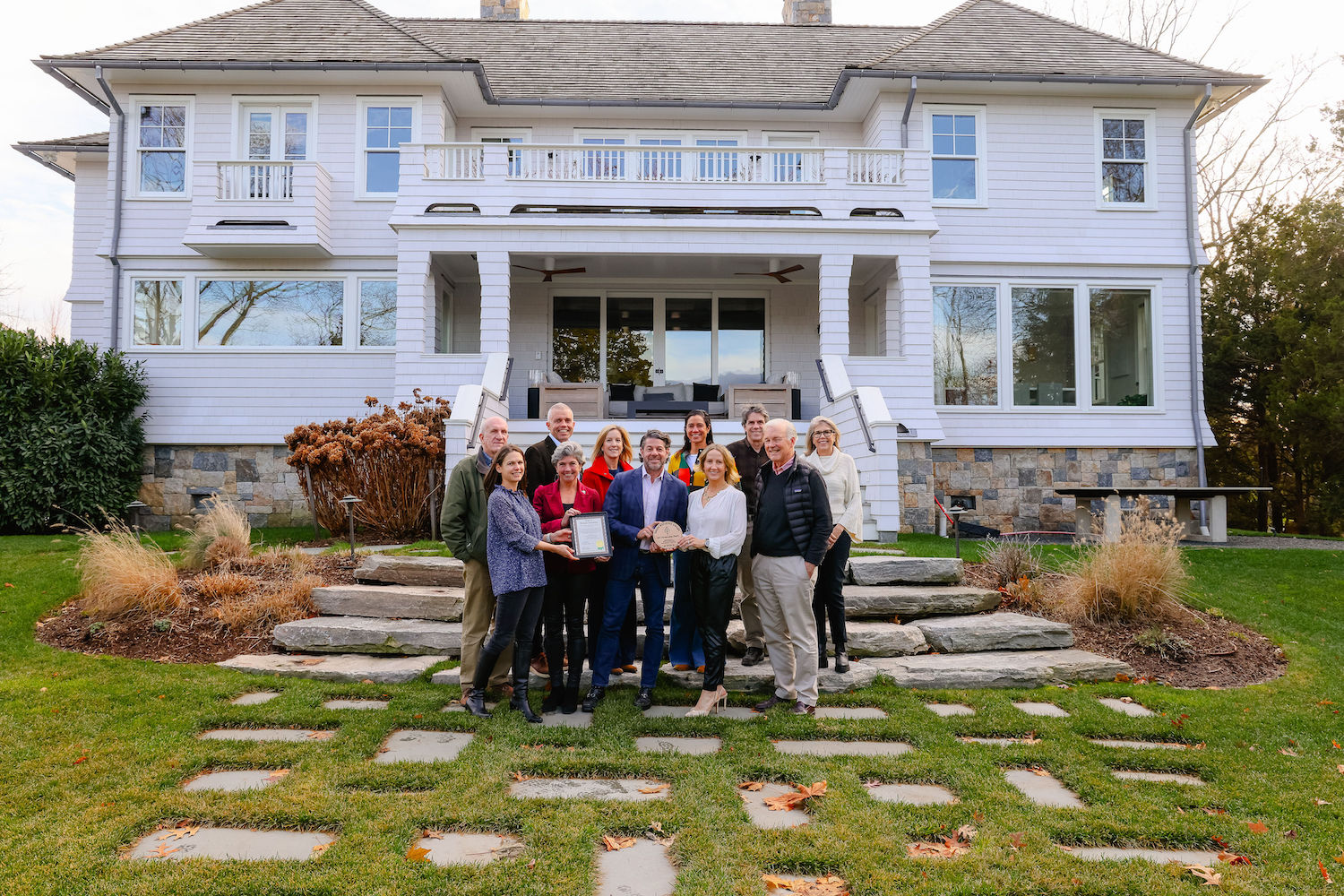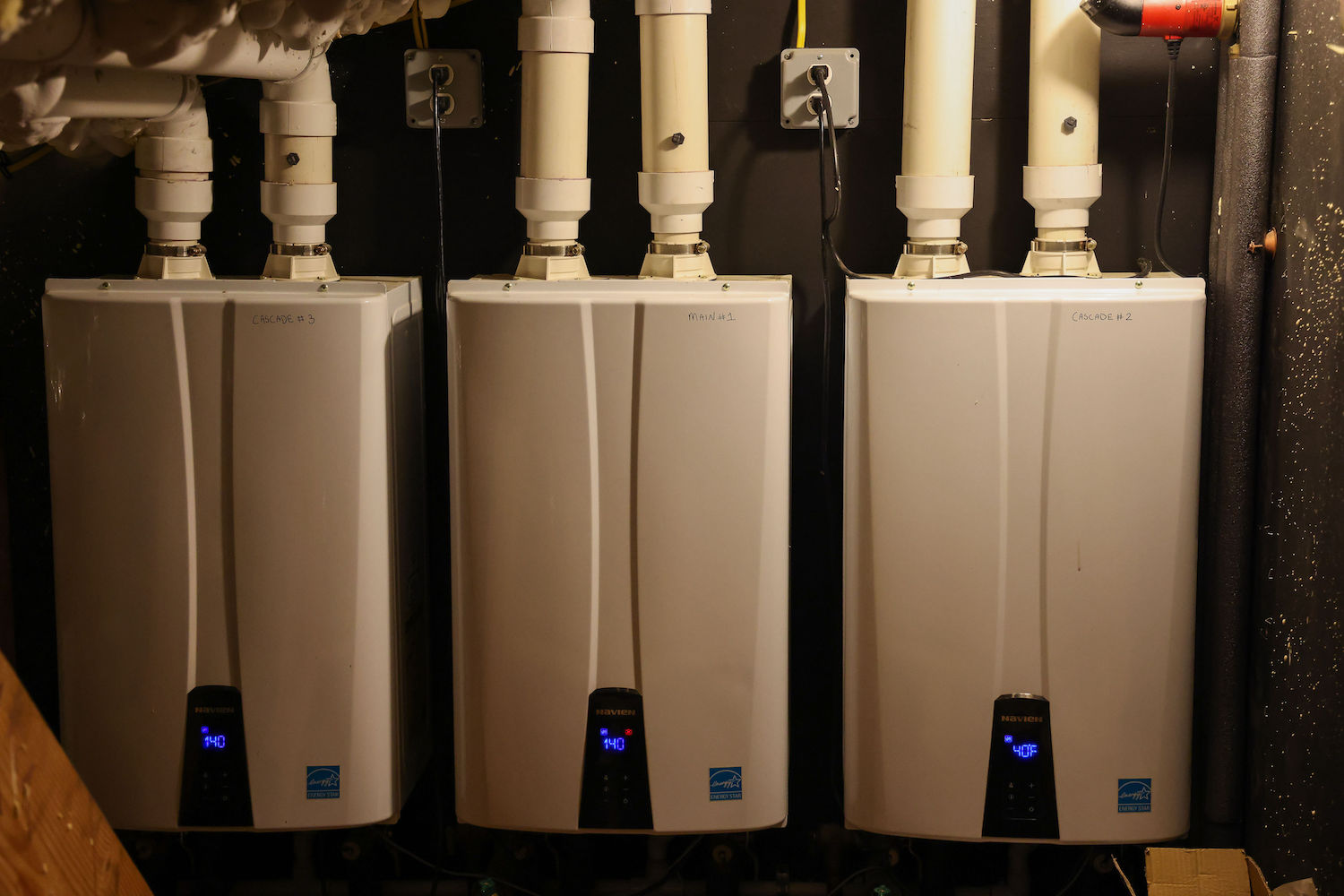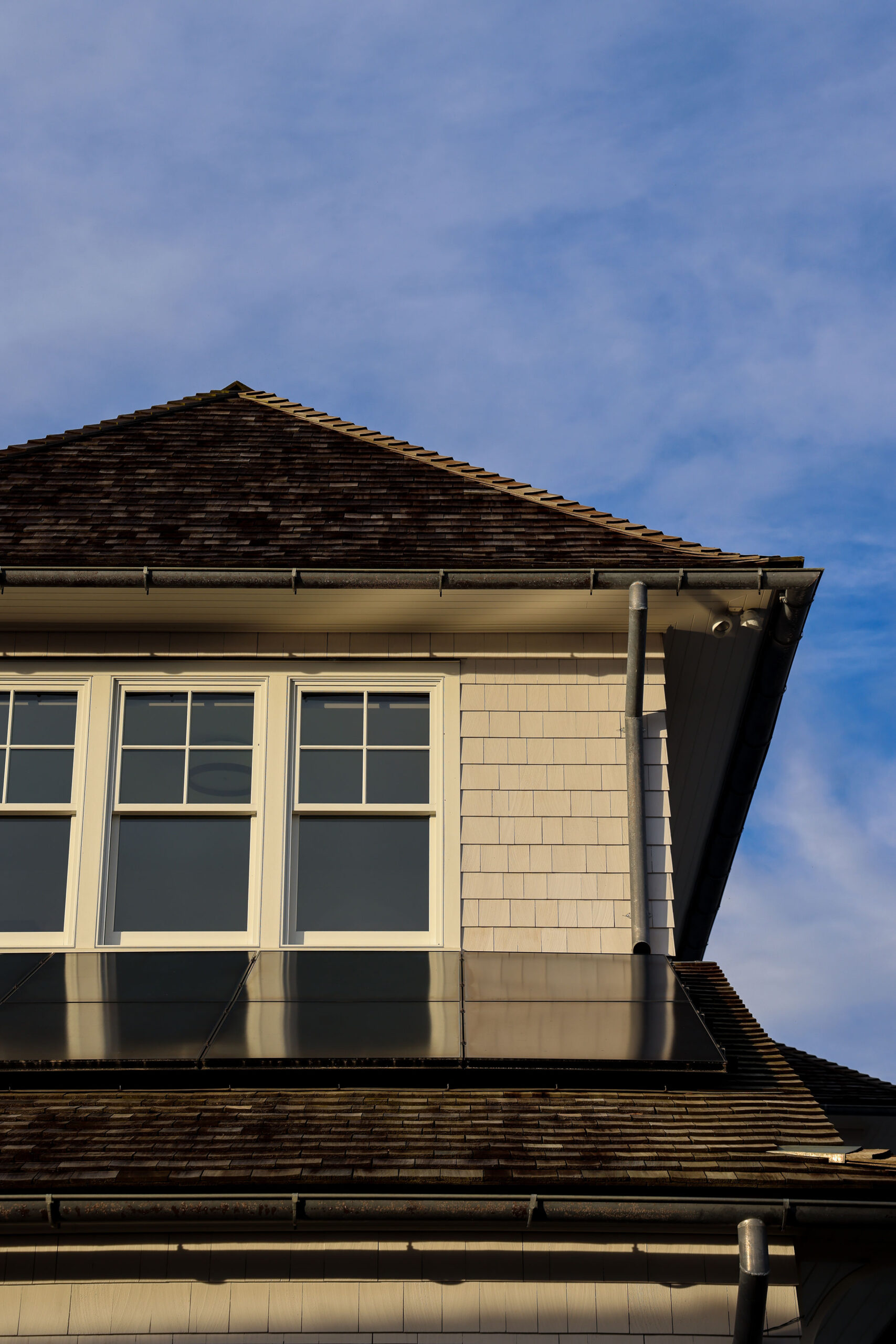Container, 1 column
1 column
1/2 column
1/2 column
1/3 column
1/3 column
1/3 column
1/3 column
2/3 column
1/4 column
1/4 column
1/4 column
1/4 column
1/4 column
3/4 column
1/5 column
1/5 column
1/5 column
1/5 column
1/5 column
1/5 column
4/5 column
1/6 column
1/6 column
1/6 column
1/6 column
1/6 column
1/6 column
1/6 column
5/6 column
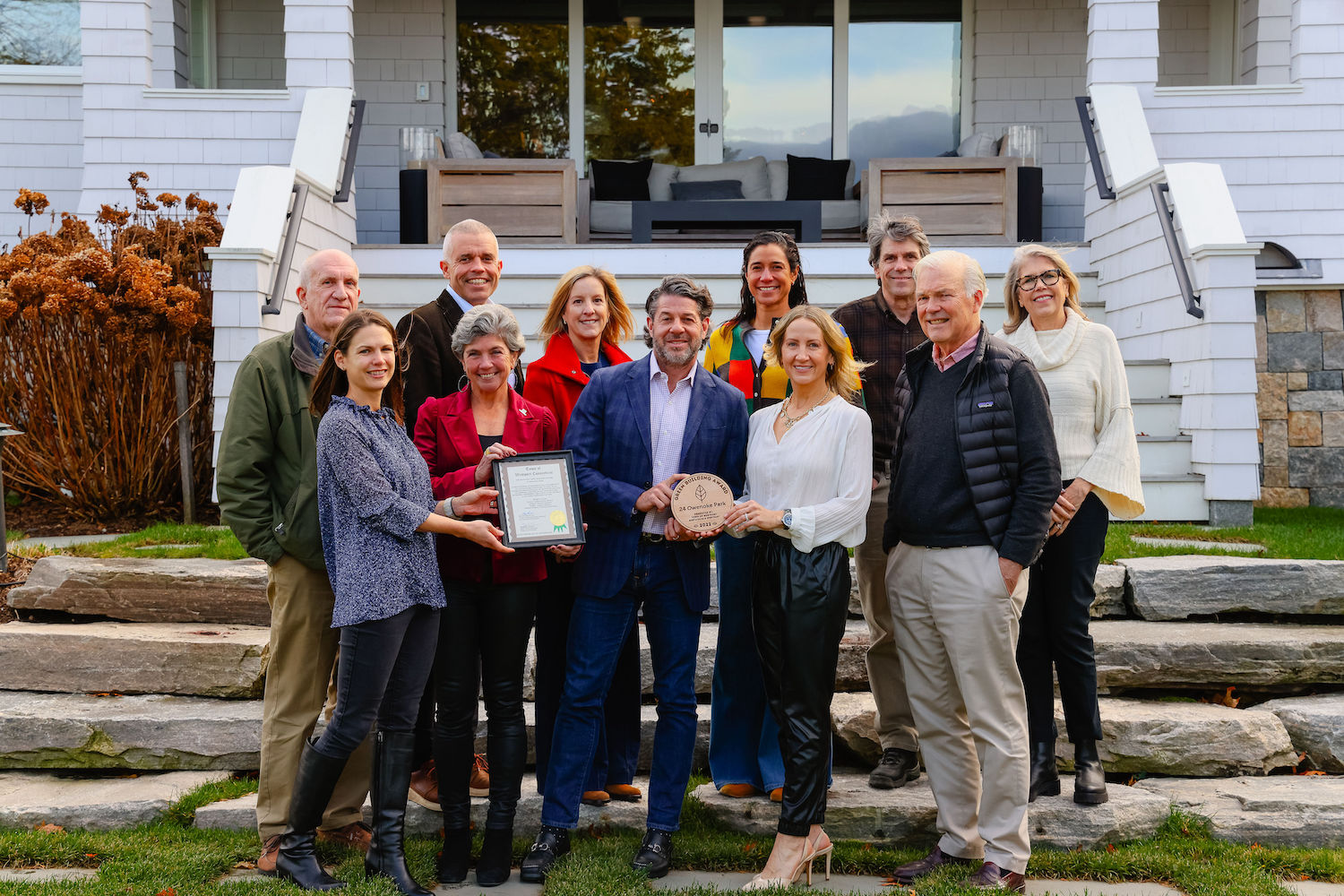
Green Building Award: 24 Owenoke Park
The Town of Westport and Sustainable Westport announced today that 24 Owenoke Park is the 2022 recipient of The Westport Green Building Award for Achievement in Sustainable Design and Construction.
Date: December 12, 2022
Owners: Keith & Kate Melnick
Architect: Jack Franzen
Builder: John & Steve Segerson, Pam Brennan, Segerson Builders
Interior Designer: Chrystal TothThe Westport Green Building Award for Achievement in Sustainable Design and Construction recognizes residential and commercial projects that make, or have made, significant contributions to sustainability and Westport’s future as a Net Zero Community. This award is a collaboration between the Town of Westport and Sustainable Westport and it acknowledges noteworthy accomplishments that add benefit to the Westport community. 24 Owenoke Park is a stellar example of what is possible with sustainable design and construction in a residential project.
When moving to Westport, CT in 2016, the Melnicks’ goal was to incorporate the sustainable building features they had discovered while living abroad in Switzerland and Australia in their new home. Sustainable aspects of 24 Owenoke Park include an efficient building envelope, use of sustainable building materials, a solar photovoltaic system, and a geothermal heating and cooling system.
The building envelope includes double pane insulated glass with low emittance coating to reflect heat and keep it from penetrating the glass. This reduces heating and cooling demands on the home, as well as the size of the heating and cooling equipment.
The heating and cooling system is an all-electric geothermal heat pump, lessening the home’s reliance on fossil fuels. When heat is required, the heat pump draws heat from the ground; when cooling is required, the heat pump rejects heat back into wells drilled 535’ into the ground. Because the ground temperature is nearly constant year-round, less energy is required to extract and reject heat to the ground than to the air.
A 7.8kW solar array installation of Photovoltaic panels produces clean electricity, powering the home, and allowing it to send electricity back to the electric grid instead of pulling from it. The solar PV panels also power an EV charger for their electric car.
Ultra-High Efficiency Tankless water heaters have also been utilized. Tankless systems provide hot water only when there is a call from a sink or shower, eliminating the need to keep the water heated 24/7.
The interior of the home includes natural finishes and furnishings as well as paint that minimize Volatile Organic Compounds (VOCs). VOCs are chemicals typically found in building materials and interior furnishings that can cause health problems. The paint also includes cradle-to-cradle (C2C) certification that not only assures the health and safety of the end product, but also sustainable manufacturing practices.
All appliances are Energy Star rated. These appliances meet energy efficiency standards set by the US Environmental Protection Agency or US Department of Energy.
To learn more about what you can do to make your home more sustainable, refer to the Sustainable Westport Green Building Awards Program, and follow the link to Guidance for Applicants.
Photography by Jenaé Weinbrenner.

The Holidays: How to Reduce Waste & Stress
Holiday stress is not uncommon. We can all relate to the social and family pressures, disruption of your normal eating and sleeping routines, and general fatigue resulting from all the extra “to-dos” on your checklist. But did you know that wastefulness is also a significant cause of underlying holiday stress? In a recent study, over half of the respondents experienced higher levels of stress and unhappiness as a RESULT of wastefulness during the holiday season.
It is true. Americans throw away 25% more trash during the period between Thanksgiving and the New Year than any other time of year. The extra waste amounts to 25 million tons of garbage or about 1 million extra tons per week!
Many people have shared with us that they feel forced to choose between enjoying the holiday or being sustainable. That does not have to be the case! To reduce your waste, help the planet, and improve your own well-being, consider some small changes on the biggest waste offenders of the holiday season:
1. Wrapping Paper
Every year, an estimated 4.6 million pounds of wrapping paper is used in the U.S., most of which ends up in the landfill or incinerator.Unfortunately, the vast majority of wrapping paper (particularly holiday wrapping paper with its glossy coatings, glitter, and foils) CANNOT be recycled. In general, masses of wrapping paper wreak havoc on recycling machinery, and the more components added to the original paper, the more challenging it becomes for recycling centers to access the actual fibers needed for recovery and recycling.
2. Gift Bags & Tissue Paper
Gift bags and tissue paper are two popular holiday items that also cannot be recycled. Similar to wrapping paper, most paper gift bags are adorned with additional finishes that make them impossible to recycle. Even if the gift bag is plain, it can only be recycled if it is brown, and the handles are removed. Tissue paper creates issues for recycling centers, so it should be trashed (or avoided altogether!).3. Bows & Ribbons
Gift bows and ribbons are also trash. Consider replacing the traditional stick-on bows and synthetic ribbon with reusable cloth ribbon. At the very least, reuse ribbon and bows rather than throwing them in the trash. If every family reused just two feet of holiday ribbon, the 38,000 miles of ribbon saved could tie a bow around the entire planet!Holiday Gift Wrapping Alternatives:
The good news is there is an increasing number of fantastic, sustainable, alternative options for holiday gift wrapping. From 100% compostable and recyclable wrapping paper, to reusable fabric wraps, and creative thrift ideas, there are plenty of ways to wrap your gift while being conscious about excess waste. Check out some of our recommendations below.
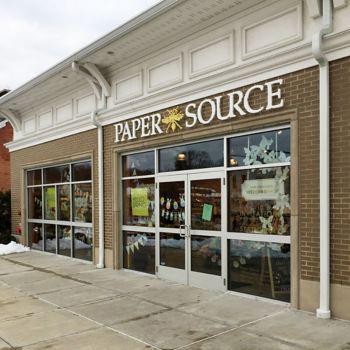
Shop Local
Look no further than Paper Source. They offer a number of fun and festive flat folded holiday papers which are 100% recyclable.
Bella Gift Wrap Company
Bella produces classic colors and designs on 100% recyclable craft paper. Sold in sets of six, Bella papers are made of 100% recycled paper and are recyclable and biodegradable.
EverWrap
EverWrap gift bags, boxes, and bows are all made to be reused. The bags and boxes are self-closing with the closures built in, so no scissors or tape is needed for gift wrapping and they are also foldable and lay flat for easy storing.
The DreamGiftNY
Handmade fabric gift bags that can be re-used for many years. They’re a fun and thoughtful way to present gifts-your friends and family will love the bag as much as what’s inside.
Get Creative & Thrifty!
Baskets, jars, tins, clay flower pots, and dust bags are easy to find and inexpensive to purchase at your local second-hand store. Rather than producing more waste, you’re providing wrapping that is useful and unique. You can always consider giving gifts in reusable shopping or produce bags as well – one can never have enough!4. Food Waste
We would be remiss if we didn’t mention the food as a top contributor to holiday waste. It is estimated that 25% of municipal solid waste is food and during the holiday season this number increases significantly. Follow these tips to help reduce your overall food waste now and throughout the year.
Rethink the Feast: How to Reduce Food Waste on Thanksgiving
Most Americans equate Thanksgiving with a feast fit for a king, with piles of delicious leftovers to be consumed in the days after the event. But the reality is this: it is estimated that 305 million pounds of food from Thanksgiving dinner will be thrown out this year. Overall, Thanksgiving food waste equates to million metric tons of greenhouse gas emissions, about the equivalent of driving 1.1 billion miles in a standard passenger vehicle. And it’s not just the waste, it’s also all the resources used to create the food that ends up in the trash—more than 1 billion gallons of water go into producing the food that is wasted each Thanksgiving.
You can still enjoy a festive holiday meal, without the waste. Consider the following tips to help reduce the amount of Thanksgiving food waste:
Plan Ahead: A key component of reducing overall food waste is simply planning ahead. Before you shop, create a list to prevent over-purchasing or impulse buys. While making your list, be sure to check your cabinets for items you might already have on hand. If you are coordinating dishes with multiple people, be sure to coordinate so you don’t overlap dishes. Also, consider simplifying your meal all together. Are multiple types of dinner rolls really necessary? Could you cut some of your side-dish recipes in half?
Consider Vegan/Vegetarian Dishes: While serving vegan or vegetarian dishes won’t necessarily result in less food waste, reducing the amount of meat you serve is more sustainable. Meat production is responsible for generating about 14.5% of total global greenhouse gas emissions and requires massive amounts of resources like water and land.
Repurpose or Compost Scraps: Save meat and vegetable food scraps for future cooking. You can freeze scraps and use them later (think: creating stock for delicious winter soups). Most importantly, don’t throw food scraps in the garbage. Check out our resources on composting at home, via the transfer station, or through a residential service here.
Take Your Leftovers Seriously: Take the time to properly store your leftovers in the fridge. Storing leftovers neatly in labeled containers will make them more likely to be eaten. Get creative with your post-Thanksgiving leftovers; try searching pinterest for thousands of ideas. If you don’t want to eat all your leftovers right away, try freezing them to enjoy later on.
Give Away Leftovers: You can also send leftovers home with your guests. Let them choose their favorite dishes so that it’s more likely they will eat – and enjoy – their leftovers!
Donate: If you have shelf stable food items you don’t end up using, consider donating to a food rescue organization or food pantry near you.
Why Should You Care About Food Waste?
There are many good reasons to avoid wasting food.
Saves Money: No one likes throwing away money. It is estimated that 25% of municipal solid waste is food. That is one in four bags of groceries – IN THE TRASH!
Saves Resources: Wasted food wastes the water, gasoline, energy, labor, pesticides, land, and fertilizers used to make the food. When we throw food in the trash, we’re throwing away all the resources used to produce it, too.
Reduces methane from landfills: When food goes to the landfill, the nutrients in the food never return to the soil. The wasted food rots in the landfill and produces methane gas. Methane is a strong greenhouse gas with more than 21 times the global warming potential compared to carbon dioxide. Composting, on the other hand, ensures that 100% of your food waste is successfully recycled into nutrient-rich soil.
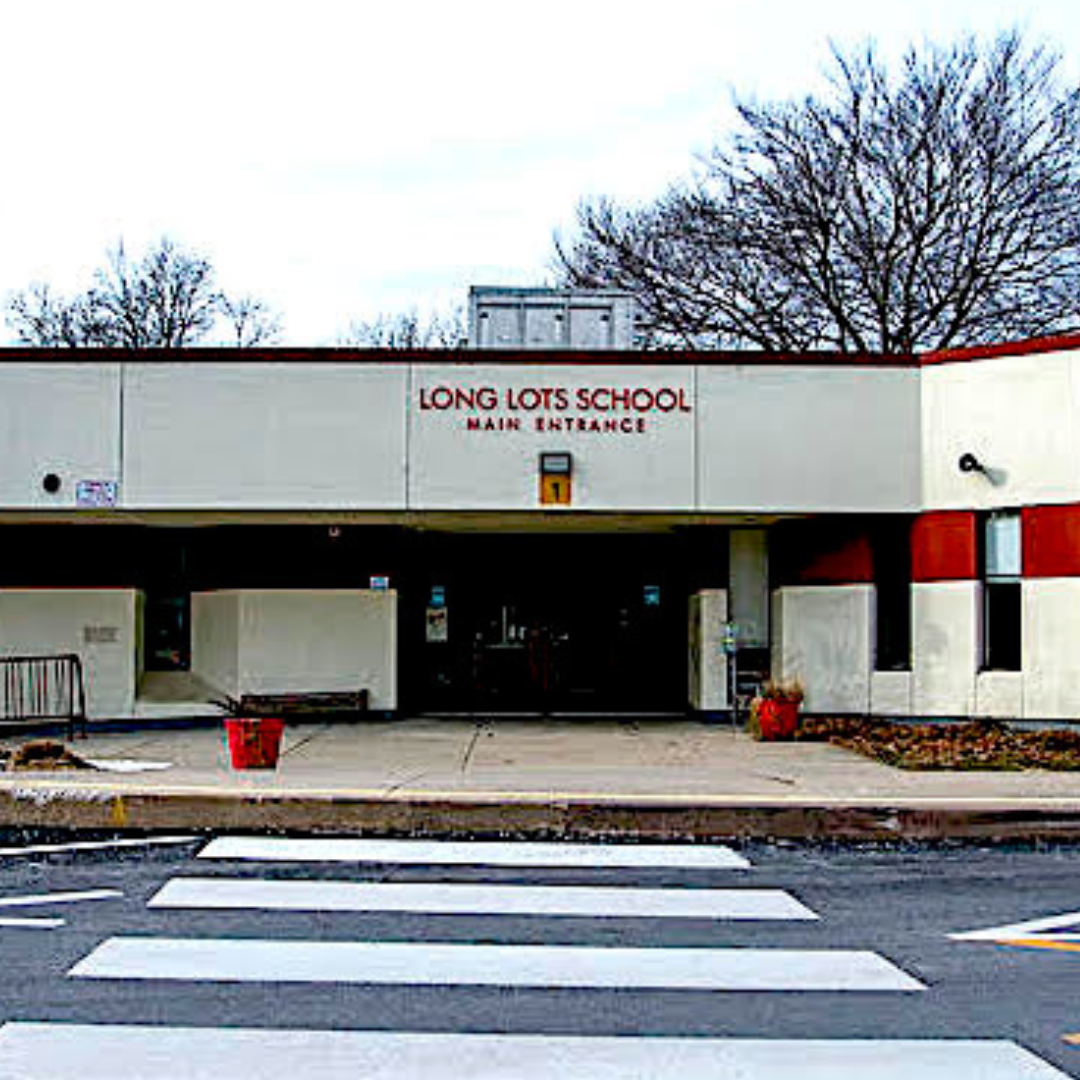
Why Should Westport Consider Building “Sustainable Schools”
Facing capacity and infrastructure issues, Long Lots Elementary School is currently being considered for renovation, rebuilding, or some combination of both. This fall, the town RTM appointed the Long Lots Building Committee, the group that will work to determine if a new build or renovation is the best course of action and develop the plans and specifications for the new space.
Whether Long Lots Elementary is renovated or rebuilt, the building represents an important opportunity to support and advance the Town’s resolution to become Net Zero by 2050. But why should Westport consider building a “sustainable school”?
Sustainable schools deliver major health, educational, financial, and environmental benefits to students, teachers, and communities. Not only are sustainable schools more efficient, leading to lower operating costs, they also provide learning spaces that significantly improve the wellness and productivity of those in and around the building.
Better ventilation and air quality: A hallmark of sustainable schools is improved ventilation and air quality. Better ventilation will decrease the spread of illness and diminish the effects of asthma, allergies, and other respiratory problems. Put simply, cleaner air will result in healthier spaces with fewer absences for students and educators. With proper ventilation, air quality improves, which results in higher student productivity. High amounts of COz slows cognitive functioning, lowering both memory and concentration levels.
Increased access to daylight: Sustainable schools are designed in a way that provides access to natural sunlight in as many spaces as possible, reducing the need for artificial light. Allowing sunlight to permeate deep into interior spaces provides numerous health benefits, including improved emotional well-being and sleep. In addition to mental and physical benefits, studies have also shown that daylight increases students’ test scores: students in classrooms with windows perform 20% faster on math tests and 26% faster on reading tests than students in windowless classrooms. Not to mention, increased daylight also reduces the reliance on artificial lighting, which decreases overall energy costs.
Lower operating costs: America’s K-12 schools currently spend $12.5 billion per year on energy costs. In Westport, the district budgeted over $3.2 million dollars for electricity, natural gas, and heating oil this school year. Pursuing net zero construction not only reduces building emissions and improves climate resilience, it also saves districts money that can then be used to re-invest in additional infrastructure updates. Compared to traditional school buildings, sustainable schools cost less than 2% more to build but use 33% less energy and 32% less water. The nation’s first net zero school opened in 2010. In its first 8 years of operation, the school saved $11.5 million.
Educational Opportunity: Sustainable schools provide a unique opportunity for students and the larger community to develop a deep connection and understanding of environmentalism and sustainability. Exposure to and education about the benefits of net zero buildings will help change mindsets leading to increased awareness and public support. Research shows that one year of climate change education can have a meaningful impact on a lifetime of emissions.
Environmental Impact: With less reliance on fossil fuels (high-performance) or no reliance on fossil fuels (net zero), sustainable schools release less pollution and greenhouse gasses while also using less energy and water. These schools are carefully designed to utilize renewable energy sources and passive systems like daylighting and natural ventilation to reduce overall energy load. As a result, sustainable schools leave a microscopic carbon footprint, while also contributing to the health and well-being of their communities.
With the rebuild or renovation of Long Lots Elementary School on the horizon, we hope to champion the development of Westport’s own net zero school for the health of our community and to advance the Town’s resolution to become net zero by 2050.How can you help support the development of sustainable schools in Westport?
Contact your RTM and the Westport Board of Education to let them know that you support the Town of Westport investing in net zero infrastructure, including schools and other public buildings. Also, keep apprised of the Long Lots Elementary School Building Committee meetings; join when you can and be sure to make your voice heard! To sign up for email alerts when meetings are announced, please click here, then add your email address under “Subscribe to Meet & News Updates.” Next, under “Calendar” select “Long Lots School Building Committee.”
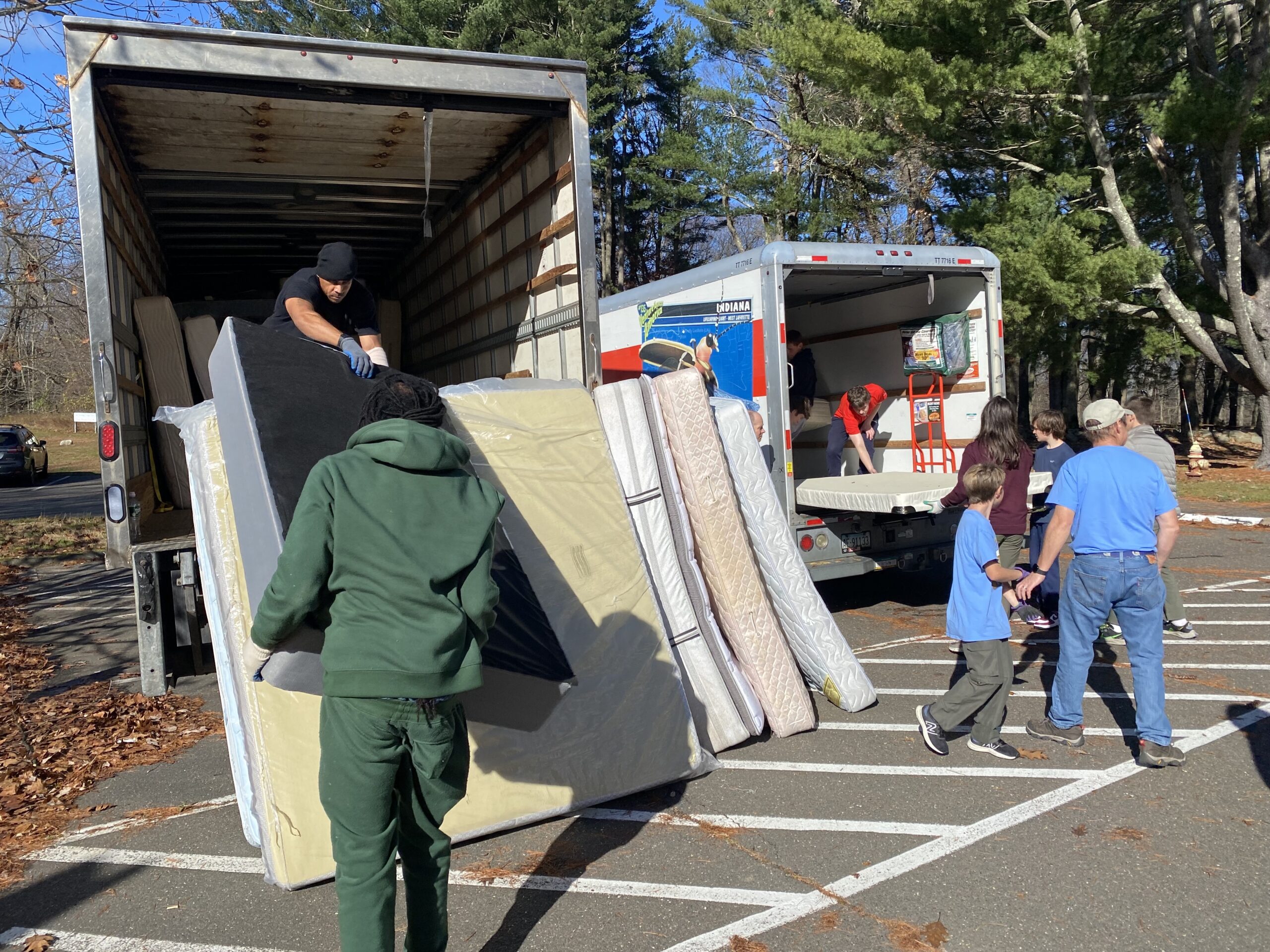
Free Bi-Annual Mattress/Box Spring Recycling Event Success!
Sustainable Westport and Earthplace’s Free Bi-Annual Mattress/Box Spring Recycling Event was a success! 61 mattresses/box springs, weighing 3,147 lbs, were diverted from the trash with the help of our recycling partner Bye Bye Mattress. Americans dispose of an estimated 20 million mattresses and box springs every year with the vast majority ending up in landfills or incinerators, even though over 90% of mattresses can be recycled into new products. Thank you for making a difference!
Special shout-out to Boy Scout Troop 36 for coordinating the pick-up of 36 of the 61 mattresses/box springs from our community!
Miss the recycling event? You can recycle your mattress or box spring anytime at (call ahead):
Park City Green
459 Iranistan Ave
Bridgeport, CT 06604
203-212-3858<
2022 House of Represenatives Candidates Share Environmental Perspectives
Candidates running for office to represent the Town of Westport in the upcoming election shared their perspectives on important state environmental issues via a questionnaire from Sustainable Westport. Responses below were provided by candidates running for Connecticut House of Representatives; District 143 (Western part of town). The candidates from District 136 did not respond.
Before voting this Tuesday, November 8, be sure to review the responses from the candidates below. A greener, healthier future starts with leaders who understand environmental issues and champion policies that will create positive change.
Nicole T. Hampton
Republican
Connecticut House of Representatives; District 143The Energy System for CT: During periods of peak energy use, natural gas sources for electricity production shrink forcing end-of-the-pipe CT to rely on dirtier coal and fossil fuel or pay peak LNG prices – with air-quality and cost downsides. The obvious long-term, environmentally and economically sustainable solution is to increase renewable sources of energy like procuring offshore wind, building solar infrastructure, or participating in a Hydro-Quebec New England transmission line. Which of these projects would you support and why? Are there any that you do not support and why?
In 2020, 55% of electricity in the state came from natural gas, and nearly 40% from nuclear power. Very little of the state’s energy needs are derived from fossil fuels—less than 1%. Wind and solar power are unreliable and have high startup costs. Those costs would be passed on to consumers, and affordable energy is already a top concern for voters living in the 143rd legislative district. Solar panels rely on chemicals to manufacture, and those chemicals must be
disposed of when the lifespan of the panels expires, trading one set of environmental hazards for another. With respect to wind, it’s not only unreliable like solar but also harmful to birds. Germany has more wind capacity than any other EU country, and they’re now having to buy coal from Africa to get through the winter. The Hydro-Quebec New England transmission line was blocked by Maine voters last year, so it is unclear how power from Canada would get to Connecticut without going through Maine or New Hampshire. And New Hampshire voters also blocked a similar effort in their state. Since our electrical grid in Connecticut only minimally relies on fossil fuels already, the cost-effective and readily available alternative is nuclear power, which is seeing renewed support among environmentalists, and has been embraced as an essential part of the energy mix in neighboring New Jersey.
Heating Homes: In the last legislative session, an initiative failed that would have prohibited using fossil fuel combustion systems or electrical resistance as the “primary” heating source in any new residential construction or major alteration. This legislation, addressing the demand side of the energy problem, was aggressively opposed by the fossil fuel industry. Would you support a new bill or are there other ways you would encourage and/or mandate the construction of high performance buildings across all sectors?
Did the sponsors of this bill know we’re in the middle of a housing shortage? Imposing these kinds of regulations on the home construction sector would only make housing less affordable, potentially tripling the costs to build new or renovate existing homes. Housing prices and rents are sky high in my district. No wonder this bill failed. The 143rd legislative district includes a range of housing options from apartment buildings to multi-family homes to mansions. Environmentalists know that multi-family housing is more environmentally friendly and sustainable than single family, but we haven’t seen a push in the CGA to eliminate single family zoning. For these reasons I would not support a new bill. I am a strong fiscal conservative. I’m also a single mom sharing an apartment with my teenage daughter. My carbon footprint is small already, but someday I might want to own my own home, like this bill’s sponsor, who owns his own home on ¾ of an acre of land. This kind of legislation is more of the same old “do as I say not as I do” hypocrisy that has turned off voters. In California environmental regulations have been exploited to keep housing prices high and keep out unwanted people. I oppose any new regulations that would make it harder for those who are struggling to live here to afford to buy homes.
Electric Vehicles: Wide-scale EV deployment is among the primary solutions for achieving the state’s statutorily required economy-wide GHG reduction targets. If a new bill supporting the Sale of Electric Vehicles in CT comes to the floor that would provide customers with the freedom to purchase electric vehicles directly from manufacturers to help transition away from fossil fuels, would you support it, and, if not, how would you suggest the state meet its Zero Emission Vehicle targets?
The automobile dealers have been working overtime to mandate that you can’t sell a car in this state without a showroom and a lot filled with inventory. It’s not a very sustainable business model, and it’s bad for the environment. Car dealers have long opposed the EV sales model, allowing consumers to buy directly from the manufacturer. Preventing makers of electric vehicles from selling directly to consumers is not only bad for the environment, it’s bad business. I would support legislation to allow EV makers to sell directly to consumers in Connecticut.
Waste: One of the state’s 5 waste-to-energy facilities closed this year, leaving CT with even fewer options for disposing of municipal solid waste. As a result, we are shipping more and more MSW to out-of-state landfills, leading to increased tipping fees for municipalities. What is your solution to this waste crisis?
For years we thought we could recycle and compost our way out of the mounting trash problem. Just a few days ago, Greenpeace USA released a report on recycled plastics. We may be putting our plastic bottles out in the blue recycle bins. But only 5% are actually recycled. That’s an epic environmental failure. And while the long-term solution may lie in the field of robotics, we’re just not there yet. In Connecticut—especially in this district—the nuances of MSW management and tipping fees can’t be untangled from each town or city’s arrangement with a private waste disposal company. The bigger the company, the greater the economy of scale, the lower the tipping fees. My solution to the MSW crisis is to continue to work with our private partners to find the least expensive option for removal of MSW.
Party position: Do you agree with your party’s position on climate change and environment? What are the areas of overlap and where do you have a different view versus the national platform?
Climate change is real, and we should take steps to mitigate the impact. Having said that, there is still considerable debate about the extent to which humans have escalated the rate of change, and more important, the extent to which embracing the most draconian climate initiatives would result in measurable differences without catastrophic impacts to food supplies worldwide. As a fiscal conservative, I also want to make sure the money taxpayers spend on green initiatives isn’t just going to support the interests of political cronies.

Dominique Johnson
Democrat
Connecticut House of Representatives; District 143The Energy System for CT: During periods of peak energy use, natural gas sources for electricity production shrink forcing end-of-the-pipe CT to rely on dirtier coal and fossil fuel or pay peak LNG prices – with air-quality and cost downsides. The obvious long-term, environmentally and economically sustainable solution is to increase renewable sources of energy like procuring offshore wind, building solar infrastructure, or participating in a Hydro-Quebec New England transmission line. Which of these projects would you support and why? Are there any that you do not support and why?
I support prioritizing renewables in our state’s energy system, especially solar and wind infrastructure. I am very open to learning more about the Hydro-Quebec New England transmission line given the potential in hydroelectric power to be utilized effectively in our state the way it has been in other states and regions. I support improving and expanding our solar infrastructure to include rooftop solar, community solar, and battery storage initiatives. I also support training and workforce development that ensures our workforce is properly trained to construct and deliver our state’s energy needs.
Heating Homes: In the last legislative session, an initiative failed that would have prohibited using fossil fuel combustion systems or electrical resistance as the “primary” heating source in any new residential construction or major alteration. This legislation, addressing the demand side of the energy problem, was aggressively opposed by the fossil fuel industry. Would you support a new bill or are there other ways you would encourage and/or mandate the construction of high performance buildings across all sectors?
I would be interested in exploring this as a solution to the demand side of our energy crisis in heating our homes. Setting ambitious yet attainable goals to ensure all municipal and government buildings are net zero should be a priority. I believe that new construction should be green and would advocate for finding innovative approaches to incentivize renewables in new residential construction.
Electric Vehicles: Wide-scale EV deployment is among the primary solutions for achieving the state’s statutorily required economy-wide GHG reduction targets. If a new bill supporting the Sale of Electric Vehicles in CT comes to the floor that would provide customers with the freedom to purchase electric vehicles directly from manufacturers to help transition away from fossil fuels, would you support it, and, if not, how would you suggest the state meet its Zero Emission Vehicle targets?
I have heard from many Westport residents at their doorsteps over the last several months, many of whom own EVs, who specifically asked for their state representative to support a bill for the Sale of Electric Vehicles in CT. If consumers overwhelmingly want this opportunity to buy EVs directly from the manufacturers and not have to go out of state to purchase their vehicles I would strongly consider supporting it. Our transition away from fossil fuels needs to be multi-pronged and agile so we should explore ways to collaborate with stakeholders to reach our goals. We will need to ensure the charging infrastructure grows along with adoption of EVs, and should incentivize the transition to electric vehicles including and especially for our public transit systems and school buses.
Waste: One of the state’s 5 waste-to-energy facilities closed this year, leaving CT with even fewer options for disposing of municipal solid waste. As a result, we are shipping more and more MSW to out-of-state landfills, leading to increased tipping fees for municipalities. What is your solution to this waste crisis?
In Norwalk (and as a member of our Council’s Public Works Committee) we have instituted curbside composting and just expanded it to an additional site. The new site is in fact in the 143rd District in Cranbury Park. This program has diverted solid waste out of our MSW tonnage and it holds promise to be a sustainable solution for the waste crisis locally so we can further minimize shipping more MSW out-of-state. We also need to further develop our education and awareness campaigns about single stream recycling to encourage even greater adoption of recycling and collaborate further with zero waste advocates to amplify their important work.
Party position: Do you agree with your party’s position on climate change and environment? What are the areas of overlap and where do you have a different view versus the national platform?
I absolutely agree with my party’s position on climate. I am incredibly aligned with the climate goals in the Democratic Party Platform. I especially overlap with my party on the goal of mobilizing “…a diverse new generation of young workers through a corps and cohort challenged to conserve our public lands; deliver new clean energy, including to low-income communities and communities of color; and address the changing climate, including through pre-apprenticeship opportunities, joint labor-management registered apprenticeships for training, and direct-hire programs that put good-paying and union jobs within reach for more Americans.”

2022 State Senate Candidates Share Environmental Perspectives
Candidates running for office to represent the Town of Westport in the upcoming election shared their perspectives on important state environmental issues via a questionnaire from Sustainable Westport. Responses below were provided by candidates running for Connecticut State Senate; District 26 (most of Westport excluding Greens Farms).
Before voting this Tuesday, November 8, be sure to review the responses from the candidates below. A greener, healthier future starts with leaders who understand environmental issues and champion policies that will create positive change.
Toni Boucher
Republican
Connecticut State Senate; District 26The Energy System for CT: During periods of peak energy use, natural gas sources for electricity production shrink forcing end-of-the-pipe CT to rely on dirtier coal and fossil fuel or pay peak LNG prices – with air-quality and cost downsides. The obvious long-term, environmentally and economically sustainable solution is to increase renewable sources of energy like procuring offshore wind, building solar infrastructure, or participating in a Hydro-Quebec New England transmission line. Which of these projects would you support and why? Are there any that you do not support and why?
I support all of the above options. We need an all of the above solutions to our energy demand challenges. The cost of energy in CT is one of the highest in the country. It is sited by residents and businesses as one of the issues they have the most difficulty confronting in their monthly budgets. Right now, the high costs of electricity, NG and home heating oil are unsustainable for many. As a result, we must take a deliberative approach and balance costs with the removal of fossil fuels. Since 40% of all of CT energy needs are supplied by our one nuclear plant, we have an imperative to advance alternative technologies as soon as possible. Some of the actions I would support include:
Build a 40% renewable energy future by 2030 and creating new, high quality jobs; Implement a comprehensive net metering program, creating fair solar compensation for ratepayers; Expand Shared Solar access; Invest in offshore wind and energy storage; Electrify the transportation sector and accelerate adoption of clean cars; expand energy efficiency programs that cut pollution and save residents and businesses money; Restore clean energy efficiency funds that were raided in 2017; Continue sustained investment in our Energy Efficiency and Clean Energy Funds.
Heating Homes: In the last legislative session, an initiative failed that would have prohibited using fossil fuel combustion systems or electrical resistance as the “primary” heating source in any new residential construction or major alteration. This legislation, addressing the demand side of the energy problem, was aggressively opposed by the fossil fuel industry. Would you support a new bill or are there other ways you would encourage and/or mandate the construction of high performance buildings across all sectors?
High performance building attributes include energy conservation, environment, safety, security, durability, accessibility, cost-benefit, productivity, sustainability, functionality, and operational considerations. High-performance buildings are designed to achieve significant energy conservation and could potentially use 30 percent less energy each year than buildings designed to meet just basic requirements. We need to transform the building industry in the coming years. Since we are in a downturn and costs of implementing this ideal construction model may be more than can be considered feasible at this time. This is an important conservation goal that should be pursued. I believe it is the future of the building sector.
I would like to see a new bill that includes high performance building sand many other energy conserving and clean technologies including distributed generation, solar, fuel cell technology that is being used widely in Japan
Electric Vehicles: Wide-scale EV deployment is among the primary solutions for achieving the state’s statutorily required economy-wide GHG reduction targets. If a new bill supporting the Sale of Electric Vehicles in CT comes to the floor that would provide customers with the freedom to purchase electric vehicles directly from manufacturers to help transition away from fossil fuels, would you support it, and, if not, how would you suggest the state meet its Zero Emission Vehicle targets?
We have debated this issue for many years in the legislature and I would lean in favor of it depending on the final language proposed. Over time, the traditional automobile companies have developed their own electric vehicles that could compete with companies like Tesla and others
Waste: One of the state’s 5 waste-to-energy facilities closed this year, leaving CT with even fewer options for disposing of municipal solid waste. As a result, we are shipping more and more MSW to out-of-state landfills, leading to increased tipping fees for municipalities. What is your solution to this waste crisis?
We have a modern countertop composting machine in our kitchen for food scraps. This technology can be used on a much larger scale. Plastic free options, smart metering, black fly larvae in landfills are just a few strategies being employed. Ocean floaters are being deployed to pick up the Great Pacific Garbage Patch trash and take it for recycling. Recycled plastics are being used for applications in roads and roofing materials and recycled glass in building materials, An example is that concrete can someday be replaced with carbicrete which is made with a steel byproducts. Countries are turning waste to energy like Sweden “ Less than 1% of Sweden’s trash is sent to landfills, and over 50% of Swedish household waste is converted into energy to heat their homes. Less than 1% of Sweden’s trash is sent to landfills, and over 50% of Swedish household waste is converted into energy to heat their homes.”
We need to support research and implementation of these and other advancing technologies in addressing our growing waste disposal challenges. We can help by changing how we find solutions in our own homes.
Party position: Do you agree with your party’s position on climate change and environment? What are the areas of overlap and where do you have a different view versus the national platform?
I was the only Republican who voted in favor of CT’s global warning bill in 2008. This bill was proposed by Governor Jodi Rell and the then DEP Commissioner Gina McCarthy who later became the US EPA Administrator under President Obama. Governor M. Jodi Rell has signed the bill requiring reductions in the state’s greenhouse gas emissions to 10% below 1990 levels by 2020 and 80% below 2001 levels by 2050. As a result of this and many other conservation initiatives I was awarded legislative Environmental Champion twice during my time in office.
The party is concerned about the economic impact of moving too quickly, creating spikes in the cost of fuel and electric energy that can have devastating impact on strained home budgets and businesses bottom line. This certainly an issue in Connecticut. I agree, however, that the use tax credits and other incentives to speed up the development of wind, solar, and other low-carbon energy, and to make electric vehicles more affordable are goals that must continue to be pursued sooner than later.
Ceci Maher
Democrat
Connecticut State Senate; District 26The Energy System for CT: During periods of peak energy use, natural gas sources for electricity production shrink forcing end-of-the-pipe CT to rely on dirtier coal and fossil fuel or pay peak LNG prices – with air-quality and cost downsides. The obvious long-term, environmentally and economically sustainable solution is to increase renewable sources of energy like procuring offshore wind, building solar infrastructure, or participating in a Hydro-Quebec New England transmission line. Which of these projects would you support and why? Are there any that you do not support and why?
The environmentally and economically sustainable solutions to energy in Connecticut are to increase offshore wind production and build our solar infrastructure. I support the goal of the Hydro-Quebec transmission line, a long-distance high-voltage direct current (HVDC) line between Radisson, Quebec and Westford Road in Ayer, Massachusetts – it would provide stability to the regional New England grid, which has energy prices that are, on average, higher than the rest of the country and the Hydro-Quebec project would significantly increase the total amount of renewable energy available on New England’s energy grid, an important consideration this winter.
I do not think the Hydro-Quebec project should be considered a one-stop solution to the state and the region’s energy system. Instead, we should push for more renewable energy source development and begin transitioning to fully electric buildings.
Heating Homes: In the last legislative session, an initiative failed that would have prohibited using fossil fuel combustion systems or electrical resistance as the “primary” heating source in any new residential construction or major alteration. This legislation, addressing the demand side of the energy problem, was aggressively opposed by the fossil fuel industry. Would you support a new bill or are there other ways you would encourage and/or mandate the construction of high performance buildings across all sectors?
In the 2022 legislative session, Senate Bill 292, An Act Concerning Heating Efficiency in New Construction and Major Alterations of Residential Buildings, was introduced. Unfortunately, although the bill made it out of the Housing Committee, it never received a vote on the floor of the Senate. I would support and be proud to co-sponsor a new bill with the same or similar legislative intent as SB 292.
Electric Vehicles: Wide-scale EV deployment is among the primary solutions for achieving the state’s statutorily required economy-wide GHG reduction targets. If a new bill supporting the Sale of Electric Vehicles in CT comes to the floor that would provide customers with the freedom to purchase electric vehicles directly from manufacturers to help transition away from fossil fuels, would you support it, and, if not, how would you suggest the state meet its Zero Emission Vehicle targets?
To meet Connecticut’s statutorily required economy-wide greenhouse gas (GHG) reduction targets of 45 percent and 80 percent below 2001 levels by 2030 and 2050 – respectively – there must be increased adoption of electric vehicles (as well as plug-in hybrids). I strongly support measures to speed up this transition to EVs. I am in favor of a bill allowing Connecticut residents to purchase electric vehicles directly from manufacturers. Federal tax credits are available for the purchase of new or used electric vehicles by income-qualified buyers and we must make certain that residents are aware of that option.
Waste: One of the state’s 5 waste-to-energy facilities closed this year, leaving CT with even fewer options for disposing of municipal solid waste. As a result, we are shipping more and more MSW to out-of-state landfills, leading to increased tipping fees for municipalities. What is your solution to this waste crisis?
The goal in resolving the waste crisis is two fold, first to reduce packaging at the manufacturing level, and second to reduce volume at the collection point. Raised HB #115 sought to address the packaging reduction effort, though it did not come out of committee this past session. I would support revisiting the effort. The first step for reducing solid waste is to update the state’s solid waste management plan, which was last done in 2016. The current “Comprehensive Materials Management Strategy” (CMMS), which was called for by Public Act 14-94, is overdue to be updated – especially considering the changes to the municipal and solid waste management since the closing of the MIRA Waste-to-Energy plant in Hartford in July of this year.
A second aspect of solving food waste is to revisit Connecticut’s 2011 commercial food waste ban. This law meant that commercial operators generating 104 tons or more of food waste a year (which comes out to two tons per week) and those within 20 miles of a certified processor, had to divert their food waste. The issue with the 20 miles radius aspect is that there were at the time, and still are, only three commercial composters in the state. These facilities are all near the state’s borders in New Milford, Danbury, and Ellington. Twenty miles from these three locations does not encompass wide swaths of the state, including New Haven, and most of Fairfield County. The first aspect of the 2011 law, the food waste weight, has been changed twice, to little effect. First, the weight was moved down to 1 ton per week with little change. Then, in 2021, the legislature lowered the threshold to half a ton per week. But, again, there was little to noimpact. There were many caveats within the CT’s 2011 law, which – for example – exempted schools.
Party position: Do you agree with your party’s position on climate change and environment? What are the areas of overlap and where do you have a different view versus the national platform?
I agree with most of the Democratic Party’s national positions regarding climate change and the environment. I believe climate change is real, poses a serious, existential threat, and has thus far had a disproportionate effect on people of color and lower-income individuals. I support the national Democratic Party’s positions when it comes to the following:
- Assisting farmers to be more environmentally conscious (including reducing
- pesticides)
- Conserving public lands and protecting our waterways
- An emphasis on increasing solar and wind energy production
- Energy-saving upgrades to low-income families’ homes/public housing
- Transitioning school buses to zero emissions
- Increasing public transportation infrastructure and access
- A focus on training and educating underrepresented groups (such as POCs, women, low-income individuals, veterans, people with disabilities, and unemployed energy workers) so they can move into technical, well-paying jobs in the growing clean energy sector.

Oh my GOURD. It’s time to dispose of your pumpkins!
By this time of year, it’s likely that your Halloween pumpkins have started to rot. It is estimated that over 1 BILLION POUNDS of pumpkins produced in the United States end up in a landfill. Before tossing your pumpkins (and gourds!) in the trash, consider these sustainable options* to help fight food waste.
- Compost it at home! If you compost at home or participate in a food scrap pick-up service you can cut up your pumpkin into smaller pieces and add it directly to your composting bin. Interested in composting and reducing food waste year round? Click here to learn more.
- Drop off at the Transfer Station: The Westport Transfer Station will accept pumpkins in their food scrap collection bins.
- Participate in the Great Pumpkin Toss! The Westport Farmers Market and Action Waste Solutions will be accepting pumpkins and gourds at the Westport Farmers Market on Thursday, November 3 from 10-2 p.m. Pumpkins also provide food for livestock. Ox Hollow Farm will utilize pumpkins to feed the cows.
- Eat it! If you purchased a variety that can be used for cooking, you can transform yesterday’s decor into something delicious. Of course, be sure to use the seeds, regardless of the pumpkin type.
*Options 1-3 are only suitable for pumpkins and gourds in their natural state. Squishy and rotted pumpkins and gourds are welcome, but please note, decorated or painted items cannot be composted.

Why You Should Consider “Leaving the Leaves”
Update: You actually do not need to remove all the leaves in your lawn this fall. In fact, “leaving the leaves” protects and fertilizes your lawn, provides shelter to insects and other critters, and helps decrease the amount of organic waste that ends up in landfills (and contributes to greenhouse gas emissions).
Here’s why experts say you should consider “leaving the leaves”:
Protect and Fertilize Your Lawn & Garden
Leaving at least some of the leaves in your yard can help fertilize your grass and other plants. David Mizejewski, a naturalist at the National Wildlife Federation, explained that leaves “fall around the root zone of these plants, where they do things like suppress weeds or other plants from growing that would otherwise compete with the trees and the shrubs,” he said. “They slowly break down and compost right there at the base of the tree/shrub, right above its root zone, where they return nutrients that the plant can then recycle and reuse next spring.”
Not only do leaves suppress weeds, but they help retain moisture and build healthy soil in your garden beds throughout the winter and early spring.
Provide Shelter Insects & Other Critters
Butterflies, bees, moths, spiders, toads, salamanders and other critters rely on fallen leaves for cover and to insulate them from the elements; they use them for laying eggs, provisioning nests, and as a food source. Leaving the leaves will ensure that when spring rolls around, we have plenty of insects to pollinate our plants and to provide food for birds and other insectivores. With the population of many insects, particularly bees, decreasing, it is more important than ever to help protect these important members of our ecosystem.
Reduce Greenhouse Gas
In 2018, the EPA estimated that yard trimmings, including fallen leaves, represented 12.1% of municipal solid waste, with roughly 13 million tons of natural waste being incinerated or dumped into a landfill each year. Leaves and other organic matter sent to landfills break down to form methane, a greenhouse gas that contributes to climate change.
Options for How to Leave the Leaves
Whether you landscape your lawn or outsource these services to a landscaping company, you have several options on how you “leave the leaves”:
- Mulch Them: Instead of raking or blowing leaves, use a mulching lawn mower to reduce them to shreds. Chopping the leaves up into small pieces will still provide the same benefits of leaving them whole.
- To the Woods! If you own woods or fields surrounding your home, use your electric/battery powered leaf blower to move leaves into those natural areas where they can decompose naturally.
- Rearrange Them: Use your rake or electric/battery powered leaf blower to create piles around trees, shrubs, and garden beds.
- Compost! Westport offers a free Yard Waste Facility where you can drop off yard waste to be composted. If you have an at-home composting system, you can also compost your leaves directly.
Sustainable Westport Superstar: The McLaughlin Family
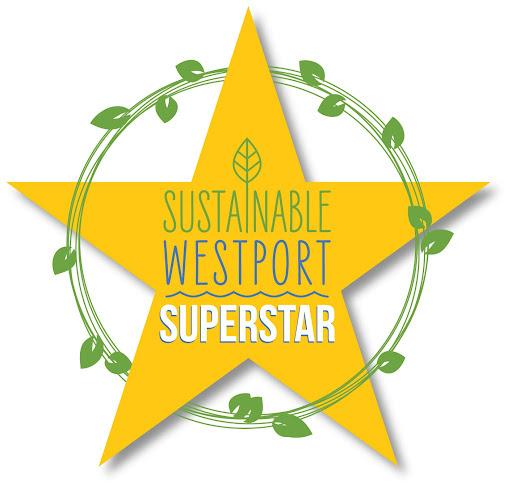
Meet Kevin, James, Harry (14), Bryson (10), Carter (9), Mandy, & Louie
The McLaughlin family, who have lived in Westport since 2015, places importance on being environmentally aware, responsible, and sustainable in a way that doesn’t feel difficult, optional, or eccentric. They have developed routines, identified products, and made small changes that have become part of how they live their everyday life, resulting in a more sustainable and healthy lifestyle.
“We do not use paper products in our home with the exception of tree-free 100% bamboo toilet paper from Grove Collaborative. Once cloth napkins wear out, they become cleaning rags and old towels are repurposed as “swiffer” pads for mopping.
In addition to composting, recycling, and using natural cleaning and lawn care products, we also try to grocery shop in a way that helps reduce our need to recycle. Instead of buying full-sized bottles or liquid refills, which are a waste of glass/plastic and composed mostly of water, we use small concentrated refills from Grove Collaborative and liquidless detergent sheets from Kind Laundry.
For our lawn, we use Sunday Lawn which is made from seaweed, soybeans, and molasses and will not harm the ground, water supply, children, or our pets. Instead of toxic pesticides, we have bat houses and pollinator-friendly sprays made from cedarwood oil and sesame seeds. In the past, we had tried both full-blown harsh chemicals and” greener” (not that green) options from lawn services, and we have found that neither worked as well as the bat houses and natural sprays against mosquitoes and ticks.
We are definitely not “crunchy,” hippies, or off-gridders. We care about the planet, our kids, and our pets. Our hope is that the little things we do will help our family and our community, and carry on through our children as they go through the world.”
THANK YOU to the McLaughlins for being a Sustainable Westport Superstar!
